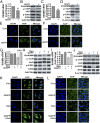Interplay of mevalonate and Hippo pathways regulates RHAMM transcription via YAP to modulate breast cancer cell motility
- PMID: 24367099
- PMCID: PMC3890879
- DOI: 10.1073/pnas.1319190110
Interplay of mevalonate and Hippo pathways regulates RHAMM transcription via YAP to modulate breast cancer cell motility
Erratum in
-
Correction for Wang et al., Interplay of mevalonate and Hippo pathways regulates RHAMM transcription via YAP to modulate breast cancer cell motility.Proc Natl Acad Sci U S A. 2016 Nov 22;113(47):E7641-E7642. doi: 10.1073/pnas.1616959113. Epub 2016 Nov 14. Proc Natl Acad Sci U S A. 2016. PMID: 27849604 Free PMC article. No abstract available.
Abstract
Expression of receptor for hyaluronan-mediated motility (RHAMM), a breast cancer susceptibility gene, is tightly controlled in normal tissues but elevated in many tumors, contributing to tumorigenesis and metastases. However, how the expression of RHAMM is regulated remains elusive. Statins, inhibitors of mevalonate metabolic pathway widely used for hypercholesterolemia, have been found to also have antitumor effects, but little is known of the specific targets and mechanisms. Moreover, Hippo signaling pathway plays crucial roles in organ size control and cancer development, yet its downstream transcriptional targets remain obscure. Here we show that RHAMM expression is regulated by mevalonate and Hippo pathways converging onto Yes-associated protein (YAP)/TEAD, which binds RHAMM promoter at specific sites and controls its transcription and consequently breast cancer cell migration and invasion (BCCMI); and that simvastatin inhibits BCCMI via targeting YAP-mediated RHAMM transcription. Required for ERK phosphorylation and BCCMI, YAP-activated RHAMM transcription is dependent on mevalonate and sensitive to simvastatin, which modulate RHAMM transcription by modulating YAP phosphorylation and nuclear-cytoplasmic localization. Further, modulation by mevalonate/simvastatin of YAP-activated RHAMM transcription requires geranylgeranylation, Rho GTPase activation, and actin cytoskeleton rearrangement, but is largely independent of MST and LATS kinase activity. These findings from in vitro and in vivo investigations link mevalonate and Hippo pathways with RHAMM as a downstream effector, a YAP-transcription and simvastatin-inhibition target, and a cancer metastasis mediator; uncover a mechanism regulating RHAMM expression and cancer metastases; and reveal a mode whereby simvastatin exerts anticancer effects; providing potential targets for cancer therapeutic agents.
Keywords: actin assembly; crosstalk; metabolism; oncogene; tumor suppressor.
Conflict of interest statement
The authors declare no conflict of interest.
Figures








Similar articles
-
Statin suppresses Hippo pathway-inactivated malignant mesothelioma cells and blocks the YAP/CD44 growth stimulatory axis.Cancer Lett. 2017 Jan 28;385:215-224. doi: 10.1016/j.canlet.2016.10.020. Epub 2016 Oct 20. Cancer Lett. 2017. PMID: 27773750
-
Metabolic control of YAP and TAZ by the mevalonate pathway.Nat Cell Biol. 2014 Apr;16(4):357-66. doi: 10.1038/ncb2936. Epub 2014 Mar 23. Nat Cell Biol. 2014. PMID: 24658687
-
TGFβ and Hippo Pathways Cooperate to Enhance Sarcomagenesis and Metastasis through the Hyaluronan-Mediated Motility Receptor (HMMR).Mol Cancer Res. 2020 Apr;18(4):560-573. doi: 10.1158/1541-7786.MCR-19-0877. Epub 2020 Jan 27. Mol Cancer Res. 2020. PMID: 31988250 Free PMC article.
-
Targeting YAP and Hippo signaling pathway in liver cancer.Expert Opin Ther Targets. 2010 Aug;14(8):855-68. doi: 10.1517/14728222.2010.499361. Expert Opin Ther Targets. 2010. PMID: 20545481 Review.
-
Control of YAP/TAZ Activity by Metabolic and Nutrient-Sensing Pathways.Trends Cell Biol. 2016 Apr;26(4):289-299. doi: 10.1016/j.tcb.2015.11.004. Epub 2015 Dec 30. Trends Cell Biol. 2016. PMID: 26750334 Review.
Cited by
-
Small molecules inhibiting the nuclear localization of YAP/TAZ for chemotherapeutics and chemosensitizers against breast cancers.FEBS Open Bio. 2015 Jun 22;5:542-9. doi: 10.1016/j.fob.2015.06.007. eCollection 2015. FEBS Open Bio. 2015. PMID: 26199863 Free PMC article.
-
CD44, Hyaluronan, the Hematopoietic Stem Cell, and Leukemia-Initiating Cells.Front Immunol. 2015 May 26;6:235. doi: 10.3389/fimmu.2015.00235. eCollection 2015. Front Immunol. 2015. PMID: 26074915 Free PMC article. Review.
-
The Hippo transducer TAZ promotes epithelial to mesenchymal transition and cancer stem cell maintenance in oral cancer.Mol Oncol. 2015 Jun;9(6):1091-105. doi: 10.1016/j.molonc.2015.01.007. Epub 2015 Feb 9. Mol Oncol. 2015. PMID: 25704916 Free PMC article.
-
YAP Inhibition by Nuciferine via AMPK-Mediated Downregulation of HMGCR Sensitizes Pancreatic Cancer Cells to Gemcitabine.Biomolecules. 2019 Oct 17;9(10):620. doi: 10.3390/biom9100620. Biomolecules. 2019. PMID: 31627466 Free PMC article.
-
Beyond Lipid-Lowering: Effects of Statins on Cardiovascular and Cerebrovascular Diseases and Cancer.Pharmaceuticals (Basel). 2022 Jan 26;15(2):151. doi: 10.3390/ph15020151. Pharmaceuticals (Basel). 2022. PMID: 35215263 Free PMC article. Review.
References
-
- Ferlay J, et al. Estimates of worldwide burden of cancer in 2008: GLOBOCAN 2008. Int J Cancer. 2010;127(12):2893–2917. - PubMed
-
- Pujana MA, et al. Network modeling links breast cancer susceptibility and centrosome dysfunction. Nat Genet. 2007;39(11):1338–1349. - PubMed
-
- Maxwell CA, McCarthy J, Turley E. Cell-surface and mitotic-spindle RHAMM: Moonlighting or dual oncogenic functions? J Cell Sci. 2008;121(pt 7):925–932. - PubMed
Publication types
MeSH terms
Substances
LinkOut - more resources
Full Text Sources
Other Literature Sources
Medical
Research Materials
Miscellaneous

